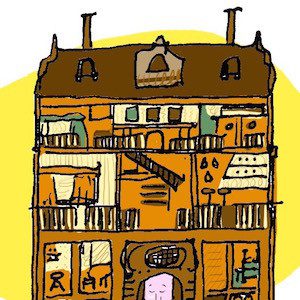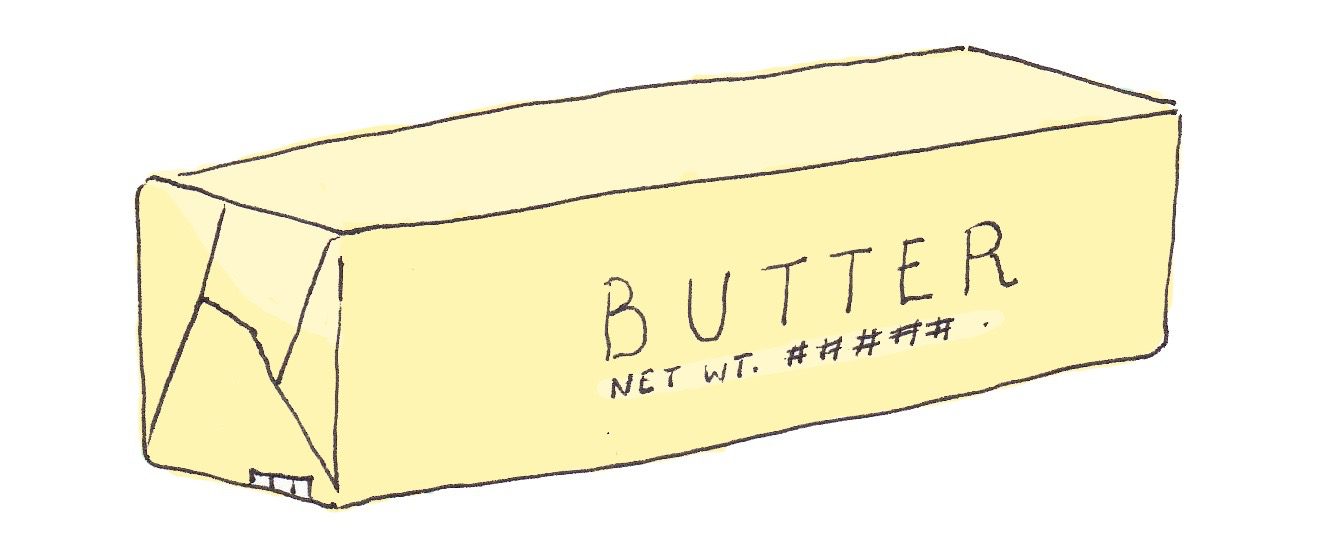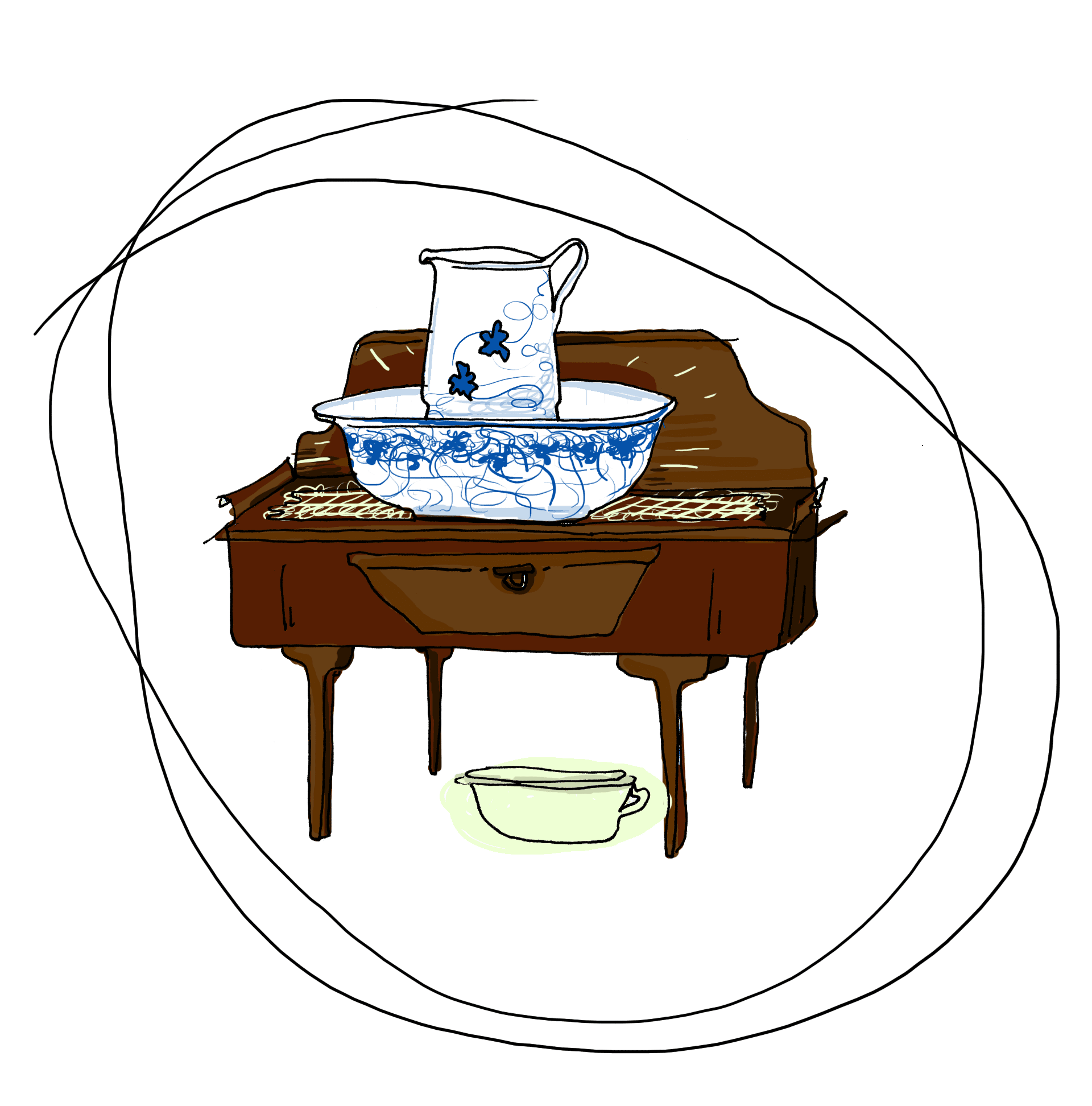
Linen Cupboard from the Stromer Baby House, Germany, 1639
I love this cupboard because it is the opposite of crush and tumble; with two working doors, three shelves, it is a perfect fit in a corner of a kitchen or even a formal dining room. Built of real walnut, not a veneer, the cabinet is much nicer than any of the furniture my husband and I own. The Baby House is called a baby house because of its size: it is a miniature replica of its owner’s house. No babies or children will ever play with it. Kept safe and perfect forever, in a glass case in the German National Museum in Nuremberg. And never mine. I will never even hold the cupboard in my hand and admire it up close.
I will only stare at the linen cupboard on my computer screen, download the image and file it in a folder on my laptop. From time to time, I will click on it, then close and hide it.
The opposite of chaos. In the fantasy of my adult life that I constructed as a child, my house was perfectly ordered and set up. And no one in the house—not the parents, not the children—ever misbehaved. Emotions in the family would be neatly arranged, static. No one yelled. No one cried. No one drank until they passed out on the kitchen floor.
No plates with half-eaten food dumped in the sink; no unmade beds. No spills. No messes. Nothing crumpled, rumpled, or torn.
The cupboard is nothing like my own linen closet as a wife and mother, a small space in our small hundred-year-old house, which has only two closets in total, a space in the upstairs hall that I open and slam shut as fast as I can whenever I put away sheets or towels without folding them. I bunch them and shove them inside, into the dark. If I fold the linens, I will, I’ve realized, resent everyone, especially my husband who is not folding anything.
No crumbs in the sheets from girls eating toast in bed, no unraveling blanket because somebody picked and picked at the hem when they were angry at their sister, no quilt that I bought at a yard sale with the batting half done that I could never finish. No one crying. No one wishing they were somewhere else.
No one praying that her parents will stop fighting, that her father will stop drinking, no one wishing that her parents would split up.
No one thinking, if I had only grown up in my mother’s house, if I had been my mother, if it were the 1950s, if I lived with more people—uncles, grandmother, cousins—I would feel safe.
I lie in bed at night and picture small cotton sheets, folded flat and tight, and tiny quilts and counterpanes, rolled up and tied with colored thread, stacked inside.
Inside The Playskool Dungeon
Psychologist Nancy Austin says that for children dollhouses can be “the most expressive medium of any that I have in my offices.” Dr. Austin uses not only traditional dollhouses in her sessions, but she also has a Playskool castle, one I remember from my own childhood, as I look across her office, with a yellow-crowned king and queen and, best of all, a dungeon with a trap door into which dollhouse people can fall, unaware, and a barred gate that locks the people in a tower.
Play therapy relies upon fantasy, and so the therapist waits, Dr. Austin tells me, as it is “the child’s story to tell”—for the child to take the lead. To drop a bad father into the dungeon. To dial 911 so that the dollhouse police will storm the dollhouse town. Dollhouse play can be a window—a portal—into a child’s internal world and as well as her experience of family life.
When meeting with children for the first time, to begin therapy, Dr. Austin asks children to “make up a story.” Often, she explains to me, the story is a narrative of disaster. A dollhouse person might jump off the roof of the house. Dollhouse parents or siblings could leave the house and simply disappear.
Ice Cubes for Miniature Drinks
On Etsy, mini ice cubes are sold in a small plastic bag for $2.25. The seller’s ad warns that the ice cubes are not “oven proof” (who would bake them?), but they can be used “in resin drinks” as if a resin drink were a new kind of cocktail.
Maybe the dollhouse father shakes the tiny cubes into his glass for a cocktail, a highball, a straight shot of gin.
The same seller offers miniature cutting boards, cross-hatched with real knife marks and sets of mixed greens, mini arugula, and radicchio, with tiny salad toppings: diced yellow peppers, onions, and slices of egg, all bagged in their own plastic.
None of this is intended for children, the seller’s website warns.
Fisher Price Ranch House
A blue and white suburban ranch, the small Fisher Price Ranch was a fantasy dollhouse my sister and I loved where we would never live. The house belonged to my sister, and I knew it was designed for toddlers, but I played with it too. We pretended it was a house in California, a state where we had never been. We wanted to live in a sub-division. We dreamed of new construction. Clean paint, with wall-to-wall shag carpet. We wanted plywood, plastic, anything new. Split level, the plastic house opened on a hinge, two rooms on each side.
In a butter-yellow plastic lawn chair on the porch sat the exhausted mother. It was the seventies so she tanned, she lay out on her lawn chair, as we imagined all mothers in California did, a scrap of tinfoil tented under her chin to better reflect the sun. The mother sunned and dozed and smoked forbidden cigarettes we made of toothpicks cracked into pieces, the tips painted with red nail polish. She chain smoked her split toothpicks, ignored her children and shut her eyes.
Miniatura
In The Poetics of Space, Gaston Bachelard famously praised the miniature: “The miniscule, a narrow gate, opens up an entire world. The details of a thing can be the sing of a new world, which, like all worlds, contains the attributes of greatness. Miniature is one of the refuges of greatness” (155). He uses examples from botany to show what miniatures have to offer. He describes a botanist with a magnifying glass who retrieves “the enlarging gaze of a child” (155). I love the idea that miniatures make our vision bigger, that miniatures are a portal.
In a synchronicity I love, the slogan of the St. Louis Miniature Museum invokes Bachelard—and paraphrases George Santayana: “Miniatures act as a window to history. We learn from the past to enhance the future.”
Dollhouse as refuge.
Dollhouse as window.
Dollhouse as gate.
In My Head I Live in My Dollhouse
“I lost my real house to foreclosure,” Louise Smith tells me.
Smith’s Miniatures, Louise’s store in St. Louis, is large, messy, and full of half-assembled dollhouses. Without a real house, Louise now lives with her parents or sleeps in the back of her store.
She tells me, “In my head I live in my dollhouse.”
There are very few dollhouse stores left in the US; most dollhouse business has moved online. My sister has found this store for me, on the outskirts of St. Louis, where she lives, and we go to Louise’s store with our daughters whenever I visit her.
The store sells furniture and dolls, some of which she has made herself, and kits to build dollhouses. What is truly remarkable—and a bit strange—about Louise’s store is that it is also designed as a space where people come to renovate their dollhouses. You can leave your dollhouse in Smith’s for weeks and then return to paint or scrape or build it whenever you like, with Louise’s expert help.
“People come here to work on their dollhouses,” Louise explains to Alissa and me. “Grandparents can come with their grandchildren. Parents can build dollhouses for their children.”
All over the store are half-finished dollhouses, dollhouses in progress. Some need shingles or shutters or windows or doors, or paint. Louise’s store is a virtual dollhouse hospital where she helps people resurrect their dollhouses. The store brings people together and emphasizes the collaborative nature of dollhouse construction and play.
Or you could see it as a dollhouse graveyard. But I don’t want to think that way.
“Which dollhouse is yours?” Alissa asks, and Louise leads us to the counter by the cash register.
Louise’s childhood dollhouse spins on a lazy Susan. Four rooms on each side, it is gorgeously furnished, in pristine condition, each room full of delicate wooden furniture, perfectly sized circle rugs, pillows set in the exact center of chairs. On a patio is a shining white wrought iron table and chairs and a barbecue set, complete with miniature tongs.
Louise tells us, “I can’t afford anything in real life. In the dollhouse world, I can afford anything I want.”
She pauses and says it again. “In my head, I live in my dollhouse.”
Louise repeats this sentence throughout our visit. And I understand exactly what she means. The world of a dollhouse is a perfect fantasy space, a world that I can control, a world that lacks all the complications of my real-sized life.
“Do you think children still love dollhouses?” Alissa asks Louise. Our three daughters are on the other side of the store, entranced by a display of miniature picnic tables and baskets.
But Louise looks back at us, not at our girls. She stares intently. “90% of people under thirty have never seen a ½-inch scale dollhouse,” she tells us. “Dollhouses have fallen out of fashion.”
Without explaining further, she says.” I want to hold something tangible.” To emphasize her point, she picks up a small flowered couch on the counter and grips it tightly.
In my head, I live in my dollhouse.
Over and over, I think about Louise’s statement. I repeat it to myself. If we could live in our dollhouses, our lives would be orderly, manageable, under control. If we could live in our dollhouses, anything could happen. But a dollhouse is a world that will never disappoint. Unlike a husband or a lover or a parent or a child or a friend.
A Tiny Butter Churn
At fifteen, like most teenage girls in the 1980s, I would never churn butter. Yet my dollhouse—which I had not played with in two years, which I quit playing with when I was thirteen—had a butter churn in the kitchen, set beside the nineteenth century icebox, painted silver inside, and the cast iron stove with a matching coal bucket. On the side porch of my real-life house, in a corner, my dollhouse was played with by no one but still set apart and saved.
I swore to myself that I would never cook with butter, would never spread butter on bread, heat it and drizzle it over meat or fish or chicken. I would never even bring butter into my house and store it in my refrigerator door. I disdained butter and all that accompanied it, fat, excess, the clear, bright, too-muchness of butter. I would even say that as a teenager and as a young woman I was afraid of butter. Of what it represented: its cool creaminess, its liquid slurry fat when melted.
And I am now much too old for this fantasy, but my dollhouse self still stands in the kitchen, aproned and ready. She would separate the milk from the cream, slowly churn it into a slurry mess, wash it in cool water, sprinkle salt on top. Tint it with a petal of yellow sunflower. The way I read in my copy of Little House on the Prairie that Ma churned butter when I was a child.
In my own real life childhood, my mother—of course—did not churn butter. She read library books and smoked in the other room. In her kitchen, there was absolutely no butter.
Because butter was outlawed I thought about it constantly.
Butter was a metaphor for all we, as girls and women, should not want.
In my childhood home, the refrigerator opened on its hinge, like a dollhouse itself, and inside all of the food was labeled with numbers, all the food was saran-wrapped and black-numbered with a Sharpie. 10 or 20 or 100. Less, of course, was best. But it was not up to me.
It was my mother who decided. Who, the year I turned fourteen, stood in the doorway of my bedroom one night and said, Honey, I will help you lose the weight. I looked up from my homework, a little shocked. I did not know that I weighed too much. I glanced down at my stomach, my math book resting on my lap. I did not know that I was too large.
It was my mother who looked up all the numbers in her Calorie Counters Guide, kept in the kitchen beside the coffee maker.
After I stopped playing with my dollhouse, after my mother lost her deeply wanted third child, her third daughter, after I had crossed into being a teenager, my relationship with my mother shifted. Instead of miniature shows to find dolls and furniture, we went to Winn Dixie to find low-calorie food. Instead of her making me objects for my dollhouse, she wrote down the calorie counts of all the food I was allowed to eat.
My mother wrote out meal plans and taped them to the refrigerator. “You can have this or this or this but not both. And not all three, definitely not” she’d say, pointing out the saran-wrapped, black-labeled bowls and plates of food, mainly vegetables, inside the refrigerator. I would nod and take her advice.
It did not matter that I was not overweight as a teenager because my new relationship with my mother, after dollhouses, was not really about weight or calories or even being thin. My mother, I began to understand, was showing me the secrets of womanhood. I was learning to begin the long struggle with my body that would continue for the rest of my life. The struggle that I still engage in every day.
The struggle about the body that I don’t want to hand down to my own daughters.
How to control it.
How to maintain it.
How to keep it small.
Now I see—and I saw it then but couldn’t articulate it—that my mother and I exchanged the pleasures of our childhood relationship—based on dollhouse and dolls and play and freedom—for the body. Which would turn out to be the very opposite of fun, the very opposite of liberating, in fact, for what would haunt me for the rest of my life: controlling my body.
My mother was teaching me the difficult rules I would have to follow in order to control my body as I moved from childhood to adulthood.
From the body of a child to the body of a woman.
From mother to daughter.
A single stick to hold in my hand. Cold and heavy and forbidden.
Bear Skin Rug with a Red Sewn-in Tongue
My mother made two bear rugs for the pink Victorian dollhouse and for my sister’s annex, one for me and one for Alissa, furry brown fabric cut out and hemmed into the outline of a bear’s body. I set my dollhouse piano on mine and let it wobble slightly. The rug made sure no one could ever play the piano because the piano’s claw feet would not sit flat.
As a teenager, my dollhouse play for the most part abandoned, I remembered the bear skin rug. Its red felt tongue, oddly sexual, the flattened reaching hands of the bear. Most of all, when I imagined sex, before I’d ever had sex, I pictured it taking place on the dollhouse bear skin rug. Two dollhouse people, bodies intertwined.
Teenage Dollhouse Wasteland
The section of the miniature show that we’re told is child friendly is called “Garage Sale” and is in a hidden floor of the Crowne Plaza hotel. It’s a messy long table full of sandwich bags and tops of boxes with remnants and broken things. “There are treasures here,” a woman behind the table tells us. “But they are buried!” She laughs.
Beside her, a teenager, a girl about fifteen or sixteen named Colleen, is running the table. She wears a black Motley Crue t-shirt and has tinted pink hair.
“My specialty is miniature food,” she tells us. “My mini food has been featured in The National Association of Miniature Enthusiasts Magazine.”
“How did you get started with miniature food?” I ask.
“I can’t afford to buy a lot of the good stuff so I make it,” she says.
Then she continues, telling me that her interest began when her mother brought home a tiny pie from a miniature show. She loved the pie.
“I’m not much of a partier,” the girl says. As if this explains her love of the pie.
A woman sifting through tiny pieces of fabric beside us adds that working with miniatures is much better than partying because, she says, “you wake up and the mini world is still there!”
My Facebook Kitchen
When I change my Facebook photo background from the Polly Pockets in my daughters’ dollhouse land—because I’ve been told by my daughters that it is so embarrassing why do you have dollhouse land on Facebook?—without thinking too much about it, I stick up a picture of a miniature kitchen I have saved on my laptop. I don’t remember where I found the picture: a pretty sunny space, in red and aqua colors. Whitewashed brick walls, a wooden table, a gingham skirted sink. A pink kettle is about to boil on the stove. A rolling pin is set carefully askew in the middle of the table. No one is in the kitchen but clearly someone—no doubt a dollhouse mother—has just stepped out of the room and will be back soon.
As soon as I post the photo, before I even admire it fully, its gorgeous colors, its Technicolor clarity, I freeze and instantly I realize that I need to explain the picture, to write a comment on my status on my Facebook page.
Because I need everyone to know that this is not my kitchen in my real-life house.
I don’t want to be the kind of middle-aged suburban mother who would photograph her kitchen and post it on Facebook. And my own real-life kitchen in my own real-sized house is decidedly un-renovated, not at all cute, and not worthy of a photograph.
But I would much rather—I would only rather—be known as the kind of woman who would post a miniature kitchen that is not hers, a miniature that she desires as her own.
In the Dollhouse Nursery
When you are a mother, the babies will not sleep.
For years, you don’t know if it is day or night—that’s how long it has been since you truly slept—you don’t know if the daughters are infants or teenagers.
Then, the daughters grow up, if you are lucky. If you are lucky, you will feel them edging away from you, wanting to escape you.
If you are very, very lucky you will get to know the daughters beyond when they are babies, beyond when they turn into girls—you will know them when they are women.
Yet for now the dollhouse nursery only offers its lessons of disappear and stay.
A dollhouse will keep you a girl forever.
How to hold on to all of that comfort that accompanies it—keep that lovely emptying of the self?
Listen, your house is not your child, not your baby.
It may not in fact be part of you.
A Wash Stand
Dark wood with a triangle shaped drawer and a blue china bowl and pitcher on top, this was where my dollhouse family washed their faces each morning. The dollhouse had a bathroom but my books on dollhouse collecting suggested every wealthy Victorian person’s bathroom would have a pitcher and a bowl. I set a tiny fake chamber pot below, but it was just for show. I always wanted a washstand in my own house as an adult. A washstand so much better than my bathroom sink now, clogged with toothpaste and girls’ hair, the sink below the mirror I stare into each night, watching myself grow older, from girl to woman to mother, watching myself becoming my own mother.
***
Rumpus original art by Kaili Doud.








